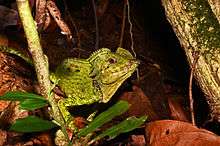Gonocephalus doriae
| Doria's angle-headed lizard | |
|---|---|
 | |
| Gonocephalus doriae, Gunung Gading National Park, Malaysia | |
| Not evaluated (IUCN 3.1) | |
| Scientific classification | |
| Kingdom: | Animalia |
| Phylum: | Chordata |
| Subphylum: | Vertebrata |
| Class: | Reptilia |
| Order: | Squamata |
| Suborder: | Iguania |
| Family: | Agamidae |
| Subfamily: | Draconinae |
| Genus: | Gonocephalus |
| Species: | G. doriae |
| Binomial name | |
| Gonocephalus doriae W. Peters, 1871 | |
| Synonyms | |
| |
Doria's angle-headed lizard (Gonocephalus doriae) is an arboreal agamid lizard found only on the island of Borneo.
Etymology
The species is named for Marquis Giacomo Doria (1840–1913), an Italian naturalist, botanist, herpetologist and politician, founder of the Museo Civico di Storia Naturale in Genoa (now the Natural History Museum of Giacomo Doria) and its director from then until his death.[1]
Description
Usually green on top with dark and light flecks and an indistinct wavy grey pattern, and sometimes with large orange patches. The dewlap/gular pouch is yellow with greyish-blue stripes. There is typically a series of transverse bars on the lower flanks and the ventral surface is lighter. There is a pronounced dorsal crest that is as high as the nuchal crest. Grows to an average snout-vent length of around 165 millimetres.[2]
Distribution
Doria's angle-headed lizard is found only in the lowland and hill rainforests of Indonesian and Malaysian Borneo.[2]
Behavior
The species is diurnal and is typically found perched on the side of a tree or sapling.[2] At night, juveniles and young adults can be found sleeping on the tops of branches with their head pointed back towards the trunk. When threatened, it will often open its mouth, but is generally disinclined to bite.
Diet
Not recorded, but likely to be primarily arthropods.[2]
Reproduction
Oviparous.[2] Little is known about clutch sizes.
Taxonomy
There is some dispute over whether Gonocephalus abbottii represents a full species or is actually a subspecies of G. doriae.
References
Further reading
- Boulenger, G.A. 1885. Catalogue of the Lizards in the British Museum (Nat. Hist.) I. Geckonidae, Eublepharidae, Uroplatidae, Pygopodidae, Agamidae. London: 450 pp
- Cochran, D. M. 1922. Description of a new species of agamid lizard from the Malay Peninsula. Proc. US Natl. Mus. 60: 1-3.
- Cox, Merel J.; Van Dijk, Peter Paul; Jarujin Nabhitabhata & Thirakhupt,Kumthorn 1998. A Photographic Guide to Snakes and Other Reptiles of Peninsular Malaysia, Singapore and Thailand. Ralph Curtis Publishing, 144 pp.
- de Rooij, N. de 1915. The Reptiles of the Indo-Australian Archipelago. I. Lacertilia, Chelonia, Emydosauria. Leiden (E. J. Brill), xiv + 384 pp.
- Evers, M. 2013. Der Traum vom Urwald im Wohnzimmer. Winkelkopfagamen (Gonocephalus) im Terrarium. Reptilia (Münster) 18 (102): 50-59.
- Evers, Michael 2010. Winkelkopfagamen. Gonocephalus belli, C. chamaeleontinus, G. doriae abbotti. Natur und Tier Verlag, 64 pp.
- Grismer, L. Lee; Chan K. Onn, Jesse L. Grismer, Perry L. Wood, Jr., and A. Norhayati 2010. A checklist of the herpetofauna of the Banjaran Bintang, peninsular Malaysia. Russian Journal of Herpetology 17 (2): 147-160
- Grossmann, W. & tillack, F. 2004. Gonocephalus doriae abbotti COCHRAN 1922. Sauria, Berlin 26 (3): 2.
- Manthey, U. & DENZER, W. 1993. Die Echten Winkelkopfagamen der Gattung Gonocephalus KAUP (Sauria: Agamidae) VI. Die chamaeleontinus-Gruppe. Sauria 15 (2): 23-38.
- Manthey, U. & Grossmann, W. 1997. Amphibien & Reptilien Südostasiens. Natur und Tier Verlag (Münster), 512 pp.
- Manthey,U. & SCHUSTER,N. 1999. Agamen, 2. Aufl. Natur und Tier Verlag (Münster), 120 pp.
- Peters, W. 1871. Uber neue Reptilien aus Ostafrika und Sarawak (Borneo), vorzüglich aus der Sammlung des Hrn. Marquis J. Doria zu Genua. Mber. k. preuss. Akad. Wiss., Berlin [1871]: 566-581.
- Taylor, E.H. 1963. The lizards of Thailand. Univ. Kansas Sci. Bull. 44: 687-1077.
- Tweedie, M.W.F. 1954. Notes on Malayan reptiles, No.3. Bull. Raffl. Mus. No 25: 107-117.